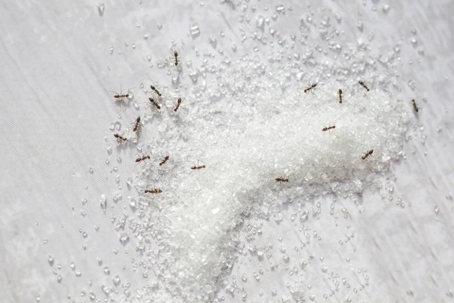What Do Odorous House Ants Eat?
Odorous house ants have a broad and adaptable diet, which is one reason they’re such persistent household pests. Their feeding habits shift with the colony’s needs, but here’s what they’re most attracted to:
- Sugars (their top preference): They aggressively seek out sweet foods, including spilled soda or juice, fruit and fruit peels, honey, syrup, jam, baked goods, and anything containing simple carbohydrates. Sugars fuel their workers and help maintain the colony’s energy needs, so they’re constantly on the lookout for them.
- Honeydew from aphids: Outdoors, their primary food source is honeydew produced by aphids and scale insects on plants. This is why odorous house ant infestations often start near trees, shrubs, or gardens with aphid activity. Colonies sometimes move indoors when outdoor sources dry up.
- Proteins and fats: While they prefer sweets, they’ll also feed on protein and oily foods when the colony needs them—for example: meat scraps, pet food, grease and oils, and dead insects. Protein is especially important during brood development.
- Moisture sources: They don’t eat water, of course, but they’re drawn to areas with moisture because they need reliable hydration. This often pulls them toward kitchens, bathrooms, leaks, or appliances.
If accessible, they’ll take advantage of anything edible—from spills behind appliances to residue in garbage cans to food in poorly sealed containers.
Do Odorous House Ants Eat Insects?
Odorous house ants aren’t major predators, but they will eat certain insects—mainly small, soft-bodied ones—when the colony needs protein. Their insect diet tends to be opportunistic rather than aggressive hunting. Here’s what they most commonly consume:
Soft-bodied arthropods
They readily feed on small, easily subdued insects such as:
Aphids (especially dead or injured ones; they don’t kill aphids because they rely on them for honeydew)
Scale insects
These are abundant in moist soil and leaf litter, where odorous house ants often forage.
Small or dead insects
They frequently scavenge—even more so than they hunt. They’ll take advantage of:
Their workers break these down into manageable pieces and transport them back to the colony.
Other small insects if easy to overpower
While not strong predators, they can sometimes prey on:
Tiny larvae (moth larvae, small fly larvae, etc.)
Weak or injured insects
Termite swarmers that have fallen and are immobilized
They’re far more likely to scavenge than actively attack healthy prey.
Insects attracted to honeydew-producing plants
Because they tend aphids for honeydew, they often pick off other tiny pests that inhabit the same plants. This behavior is opportunistic rather than intentional predation.
Do Odorous House Ants Eat Animals?
Odorous house ants are not active predators of larger animals, but they will feed on small, soft-bodied, or easily accessible non-insect foods when a protein source is needed. Their behavior is primarily scavenging, not hunting. Here are the types of non-insect animals they’re most likely to consume:
Small vertebrate carrion
While they don’t kill vertebrates, they will scavenge from:
They only feed on accessible soft tissues, and only when decomposition has already broken things down.
Eggs (if accessible)
They occasionally consume non-insect animal eggs if they come across them, such as:
Spider egg sacs
Small reptile eggs (rare and opportunistic)
Bird or reptile egg residue from cracked, already-compromised eggs outdoors
Protein residues from pet food
While not “animals” in the wild sense, pet foods are made from animal proteins and act as a major attractant:
Cat food
Dog food
Wet food residues
Dropped kibble
Pet food is one of the most common non-insect animal-based protein sources odorous house ants exploit in and around homes.
Do Odorous House Ants Eat Plants?
Odorous house ants don’t actually feed on plant tissue the way many herbivorous insects do. They rarely chew leaves, stems, or roots. Instead, they’re drawn to plant-related resources, especially sugary secretions, and they use plants mainly as foraging sites or shelter.
Here’s what they’re most likely to consume that is associated with plants:
Honeydew (their primary plant-related food)
This is by far the most important plant-derived resource. Honeydew is the sugary liquid excreted by:
Aphids
Scale insects
Mealybugs
Whiteflies
Odorous house ants tend these insects like livestock. They protect them, move them, and feed almost daily on the honeydew they produce. This relationship is the main reason these ants thrive around trees and shrubs.
Nectar from flowers
They’ll readily drink natural nectar when available, especially from:
Small flowering shrubs
Ornamental garden plants
Fruit tree blossoms
Weedy flowers like dandelions or clovers
Nectar’s high sugar content makes it a reliable energy source.
Plant sap (rare, opportunistic)
They don’t actively chew plants, but they will feed on sap only when:
A plant is damaged
Sap is already leaking from wounds
Other insects have created an opening
They don’t create these wounds themselves.
Rotting plant material (very occasional)
They may scavenge sugars from:
Overripe fruit on plants or the ground
Decaying berries
Fermenting plant juices
This is still secondary to honeydew and nectar.
Extrafloral nectaries
Some plants secrete nectar outside of flowers—examples include:
Peonies
Passiflora vines
Some fruit trees
Certain shrubs and ornamentals
Odorous house ants will feed on these secretions when available.
What they do not eat
They do not typically eat:
Leaves
Grass
Stems
Roots
Seeds
They are not plant-damaging pests in this way.

